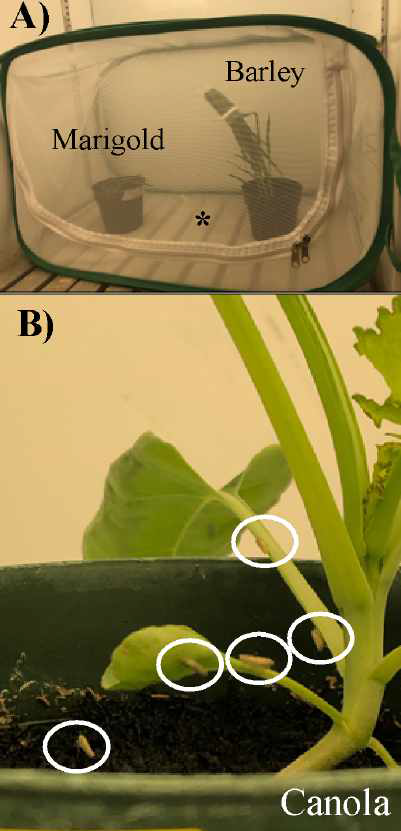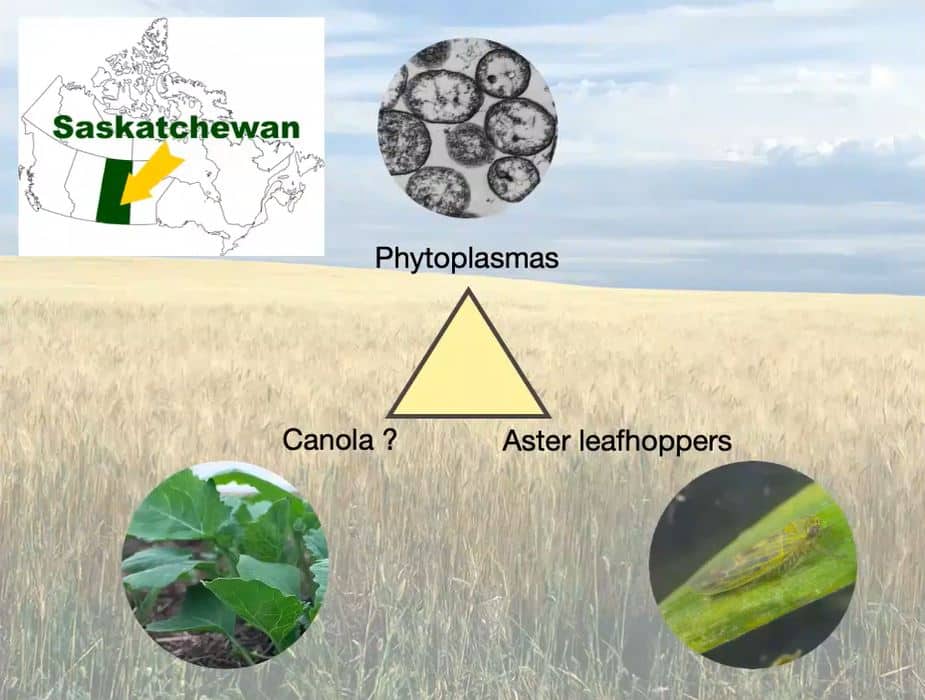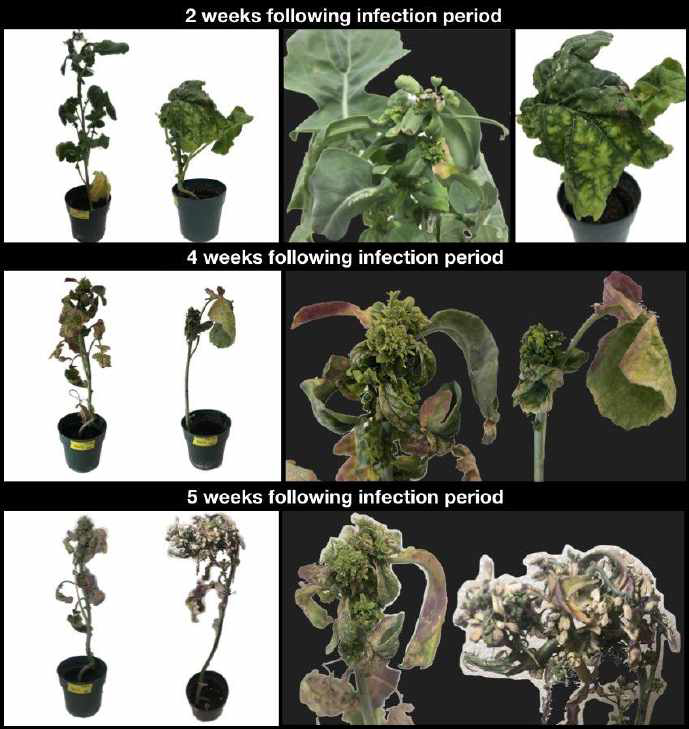Key Result
This project evaluated several crop and non-crop species commonly found in the Canadian Prairies as possible hosts for aster leafhopper development and/or phytoplasma infection.
Project Summary

Overview
Aster leafhoppers (Macrosteles quadrilineatus Forbes) (Hemiptera: Cicadellidae) are the main vector of Aster Yellows Phytoplasma (AYp) (Candidatus Phytoplasma asteris) in the Canadian Prairies. AYp causes Aster Yellows (AY) disease in over 300 plant species, but is especially problematic in canola.

2022 Soils and Crops presentation – Aster Yellows: Symptom expression and disease reservoirs
These migratory insects arrive in Saskatchewan almost every spring. However, researchers wanted to learn more about what the leafhoppers do when they arrive, as their arrival date typically precedes the emergence of crops in cultivated fields. They also wanted to examine their food and reproductive host preferences on non-crop plants and compare plant preferences to identify which plants likely sustain them prior to moving into crops. In addition, further understanding of the disease dynamics of AY in Saskatchewan is needed.
For example, the source of the AYp infecting leafhoppers each year is unknown. The AYp could originate from plants in the source areas of the leafhopper migration, which would be the case if the aster leafhoppers migrated with a high percentage of infected individuals. The alternative hypothesis is that the aster leafhoppers migrate into Saskatchewan and acquire the AYp infection from local plants. A combination of these hypotheses is also possible. However, little is known about the host range of aster leafhoppers or their host choice selection behavior in this geographical region that might drive leafhopper movement among plants.
Several crop and non-crop species commonly found on the Canadian Prairies were evaluated as food and reproductive hosts for aster leafhoppers through no-choice bioassays. To study possible effects of pathogen infection on host choice, AY-uninfected and AY-infected insects were used. Cereals and some non-crop plants like fleabane were suitable reproductive hosts for aster leafhoppers, with higher numbers of offspring observed in treatments using both AY-uninfected and AY-infected insects, suggesting an egg-laying preference on these plant species.
Development was similar across the different plant species, except for canola and sow thistle, where growth indexes were lower. Sex-ratios of aster leafhopper adults did not differ among the plant species or with respect to AY infection. Potential fecundity differed across plant species and was affected by the AY infection status of the insect.

These findings have implications for AY epidemiology and suggest that while cereals can be suitable host plants for aster leafhopper oviposition and development, some non-crop species could act as alternate hosts for leafhoppers that migrate into the Canadian Prairies before emergence of cereal and canola crops. Host choice selection behaviour accounting for both feeding and reproductive choices by aster leafhoppers was evaluated through two-choice bioassays, using domesticated and wild plants species commonly found in the Canadian Prairies.
Leaf tissues from these plants were collected and stained to quantify the number of stylet sheaths and eggs using AY-infected and uninfected leafhoppers. When two domesticated or wild plant species were presented together, similar numbers of uninfected aster leafhoppers were observed on both plant species in most combinations. In domesticated versus wild plant bioassays, AY-uninfected aster leafhoppers preferred to settle on the domesticated species. There was little to no association between settling preferences and stylet sheath and egg counts.
These findings provide a better understanding of AY epidemiology and suggest that after domesticated species germination, leafhoppers could move from nearby wild plants into the preferred cereals to settle on them, influencing the risk of AYp infection in some of these species. Through field surveys for AY symptomatic and asymptomatic biennial and perennial non-crop plants that were searched for and found reservoir plants that are the likely source of AYp infections acquired by migrating leafhoppers.
The research team also captured and tested early-season migrant leafhoppers as they arrived in Saskatchewan to determine how many of them were infected with AYp when they migrated. Surprisingly, the migrant generation had very low levels of infection, while several common plant species were harbouring AYp infections in the early spring and summer (alfalfa) and are likely acting as reservoirs for AYp in Western Canada.
Key outcomes
● When given a choice between a crop (including canola and three cereals) and a non-crop (weedy plants common in field margins), aster leafhoppers preferred crop plants over weedy plants and this preference likely drives their movement into crops from field margins.
● AYp infection status of aster leafhoppers only influenced one of the studied preferences, indicating that infection with the phytoplasma likely does not have a strong effect on the behaviour or reproductive potential of the vector insect on the tested plants. The only preference shown was for AY-uninfected leafhoppers to preferentially settle on non-crop hosts, which may indicate a preference for plants where AYp infection can be acquired.
● Canola and sow thistle were poor reproductive hosts for aster leafhoppers, yet sow thistle was one of the plants identified as an AYp reservoir. Cereal plants and fleabane were very suitable for aster leafhopper oviposition and nymphal development. This suggests that prior to crop emergence, a plant species such as fleabane could act as a suitable reproductive and food choice for aster leafhoppers. However, in the presence of an additional plant species, fleabane and other weedy species are less preferred (for settling, probing, and ovipositing), indicating that little reproduction is happening on the dicotyledonous weeds in the field margins.
● Each year, the percentage of migrant leafhoppers arriving infected with AYp was very low, but several perennial and biennial plants harboured AYp infections in the spring and summer and are likely acting as reservoir plants for AYp infection of aster leafhoppers (alfalfa, sow thistle, stinkweed, dandelion).
● AYp infection studies of several plant species were conducted (Arabidopsis thaliana, barley, canola, dandelion, wheat, and sow thistle) and descriptions of resulting symptoms and pictures of non-symptomatic and AY-symptomatic plants are included for educational purposes.
● Several of the potential reservoir plants (such as dandelion and sow thistle) were tested in no-choice and two-choice assays. The presence of stylet sheaths and the settling of leafhoppers on these plant species strongly suggest that dandelion and sow thistle are part of the AY disease cycle.





